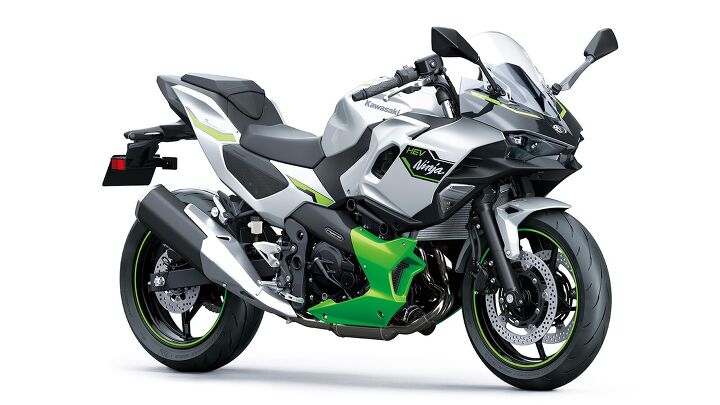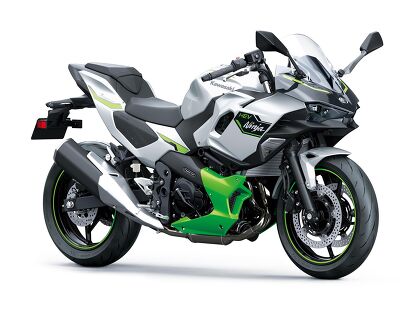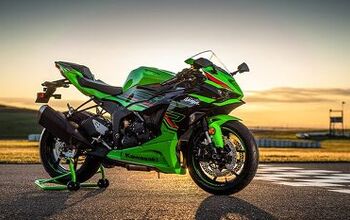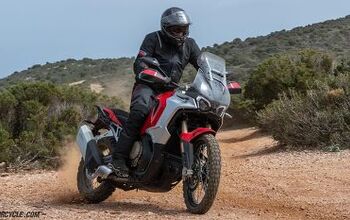2024 Kawasaki Ninja 7 Hybrid – First Look

Kawasaki claims the first strong hybrid motorcycle to enter mass production
Hot on the heels of the announcement of its first electric street bikes, Kawasaki has taken another big step towards a carbon neutral future by revealing details about its first hybrid motorcycle. Unlike the Ninja e-1 and Z e-1, however, the 2024 Kawasaki Ninja 7 Hybrid aims to be more than an urban commuter or entry-level motorcycle.
Kawasaki claims the Ninja 7 Hybrid will be the first mass produced motorcycle (excluding scooters) from a major manufacturer with a “strong hybrid” system, meaning it can run on gas, electricity, or a combination of the two.
With the name “Ninja 7 Hybrid”, Kawasaki signals its intention of it being competitive with 700cc models, or perhaps more specifically to Kawasaki, 650cc motorcycles that make up much of its middleweight offerings.
Despite the 7 in its name, the Ninja 7 Hybrid actually comes equipped with a liquid-cooled 451cc Parallel-Twin. Kawasaki hasn’t provided very much detail about it, but from its displacement we suspect it is based on the engine from the Eliminator, which itself is based on the Ninja 400 engine. Looking at the supplied photo of the powertrain, the engine does look similar to the Eliminator’s, but with a different sump, and crankcase covers, with the left side including an air intake funnel.
Kawasaki claims the engine produces 58.3 hp, which is actually more than the Eliminator produces. Supplied photos of the TFT display show an indicated redline of 11,000 rpm. Of course, the engine is only half the story, as it is paired with an electric motor which increases the output to a claimed 68.5 hp of hybrid net power. That would put the Ninja 7 Hybrid slightly ahead of the Ninja 650 and Z650 which claim 67.3 hp at 8,000 rpm.
No torque figures were provided, but thanks to the immediate torque output from the electric motor, Kawasaki claims the Ninja 7 Hybrid has a level of acceleration from a standing start that rivals a literbike supersport.
The Hybrid comes with three ride modes, Sport-hybrid, Eco-hybrid, or EV. Sport-hybrid and Eco-hybrid provide different riding characteristics, with a focus between performance or fuel economy. Kawasaki didn’t provide any specifics, but did note that fuel economy will be on par with a 250cc class motorcycle. EV is an all-electric mode with a limited speed and range designed for riding in areas where noise may be an issue, such as quiet residential areas or parking garages. Like the e-1 models, there’s also a “walk mode” to provide electrically-assisted movement in forward or reverse for low-speed maneuvering.
Unlike the electric models, the Ninja 7 Hybrid comes with a six-speed transmission, but unlike Kawasaki’s gas-powered models, the clutch is automatic. There is no clutch lever or gear shifter on the left footpeg. Instead, the left switchgear includes a toggle for switching between automatic and manual transmissions, along with an upshift “+” on the front and a downshift “-” button facing the rider.
Kawasaki also designed the engine with an idling stop function, which shuts down the engine when fully stopped to save fuel and reduce emissions. Kawasaki also added what it calls an Automatic Launch Position Finder function which automatically shifts into first gear when starting from a standstill.
The Hybrid uses a new steel trellis frame with the engine, motor and 48V lithium-ion battery packaged under the seat. Kawasaki says these elements are positioned to optimize weight distribution.
The mechanical componentry is covered by a fairing with intake scoops on either side of the header pipes. From the photo of the engine above, we assume the left intake provides cooling air towards the powertrain, while the right intake leads to a tunnel that directs cooling air towards the battery.
Up front, the Hybrid sports a fairing with the now familiar jutting chin that we find on other Ninja models. The forward turn indicators are also embedded in the front fairing as it is on other members of the Ninja family.
Kawasaki did not provide details about the suspension system, but on visual inspection, we see a telescopic fork that resembles the one on the Ninja 400. The swingarm also resembles the unit on the Ninja 400, but the Ninja 7 Hybrid uses a different linkage system.
The wheels also appear similar to those of the Ninja 400, and the tire markings indicate tubeless Dunlop Sportmax Q5A tires, with a 120/70ZR17 up front and a 160/60ZR17 at the rear. The front wheel sports dual disc brakes with Nissin two-piston calipers resembling the ones on the Ninja 650. The rear wheel, however, has a two-piston Nissin caliper instead of the 650’s single-piston caliper.
We’ll have to wait until full specifications are released to know more, including how much the Ninja 7 Hybrid weighs.
The 2024 Kawasaki Ninja 7 Hybrid comes in silver and black with a lime green lower fairing, and is expected to arrive in European showrooms in January. U.S. availability remains to be determined, but we may see it pushed back to a 2025 model year here.
Become a Motorcycle.com insider. Get the latest motorcycle news first by subscribing to our newsletter here.

Dennis has been a part of the Motorcycle.com team since 2008, and through his tenure, has developed a firm grasp of industry trends, and a solid sense of what's to come. A bloodhound when it comes to tracking information on new motorcycles, if there's a new model on the horizon, you'll probably hear about it from him first.
More by Dennis Chung



















































Comments
Join the conversation
When people vote in elitists that have an agenda based on ‘rules for thee but not for me’ this is what you can expect.
Motorcycles are being designed to run on insect carcasses, just like we'll shortly be doing. Both the rider and bike will dine from the same fuel tank!